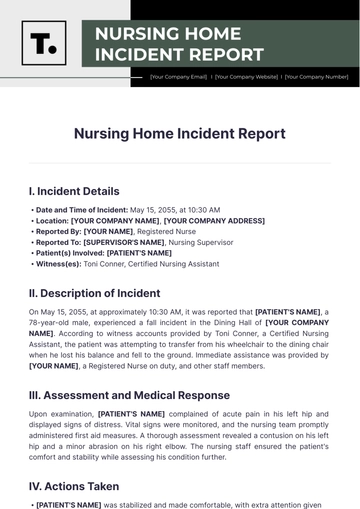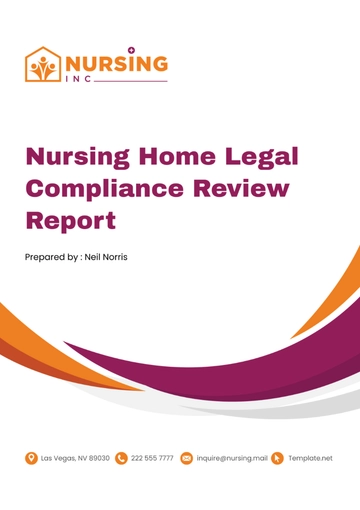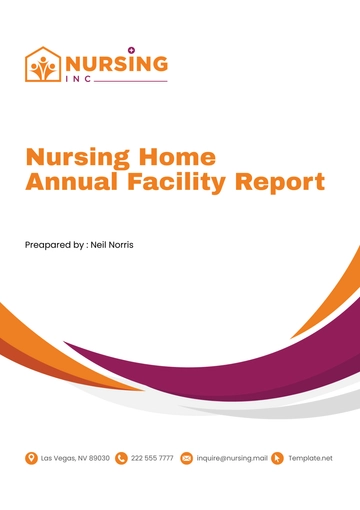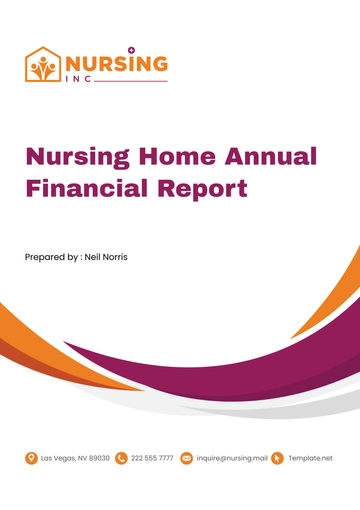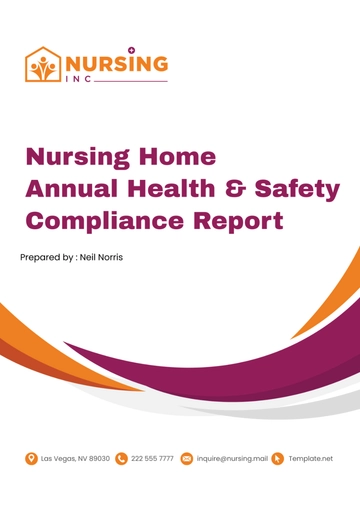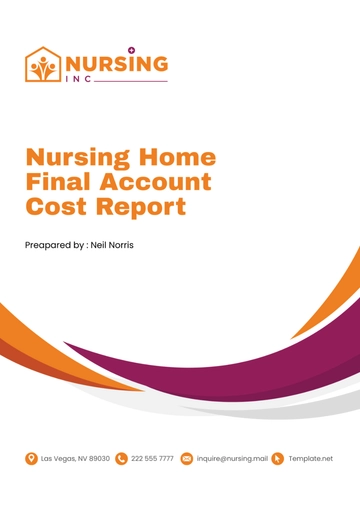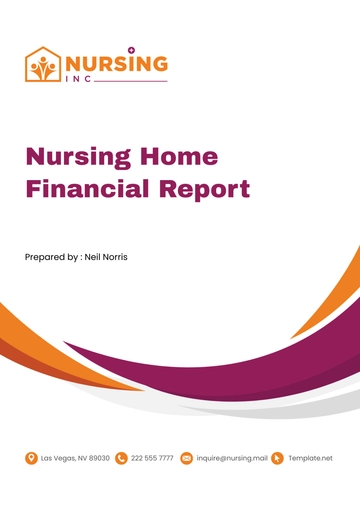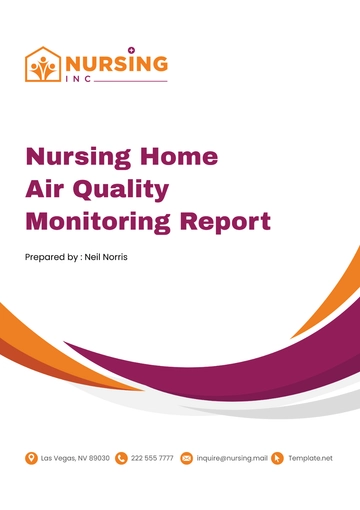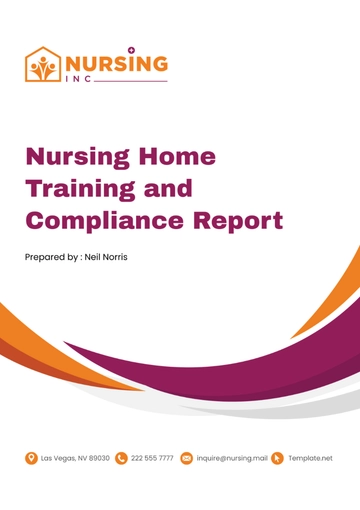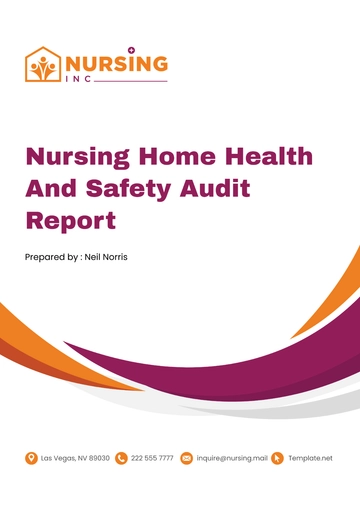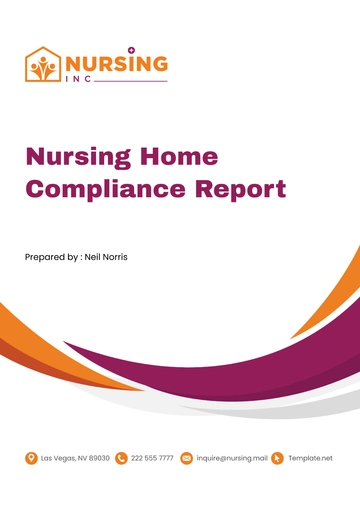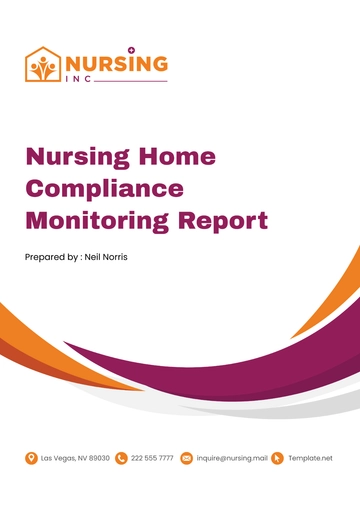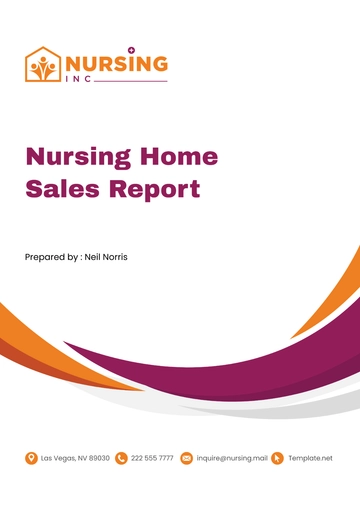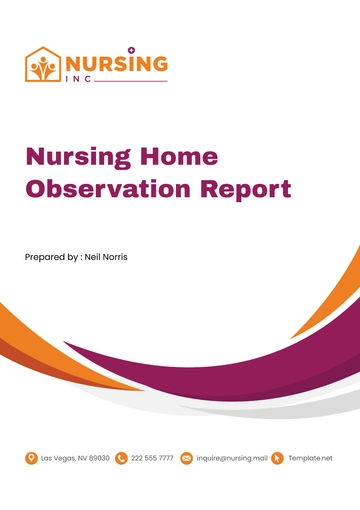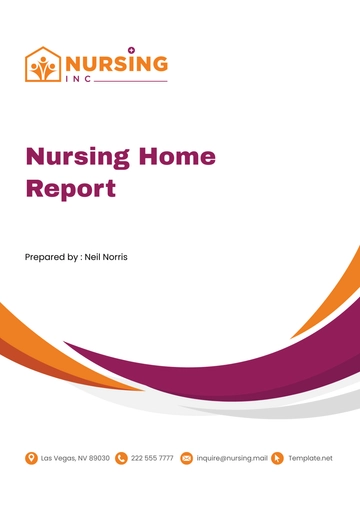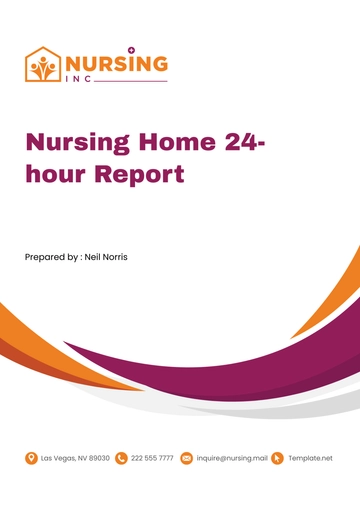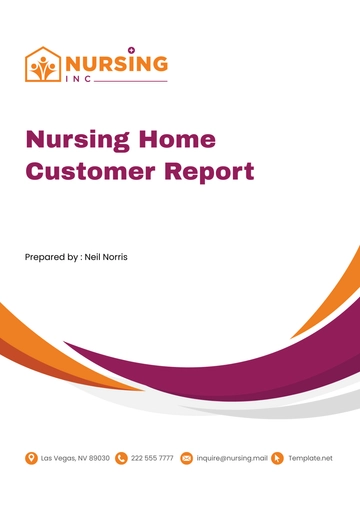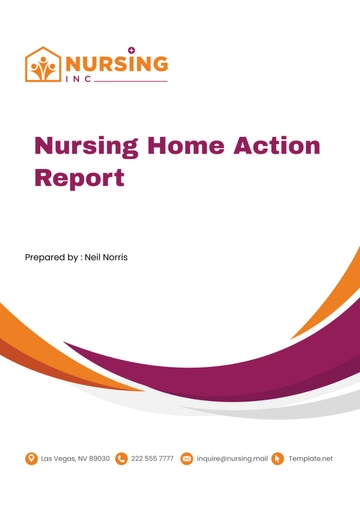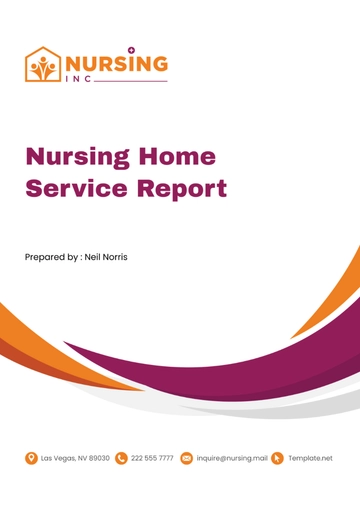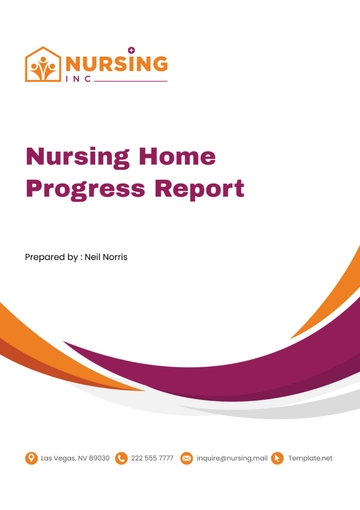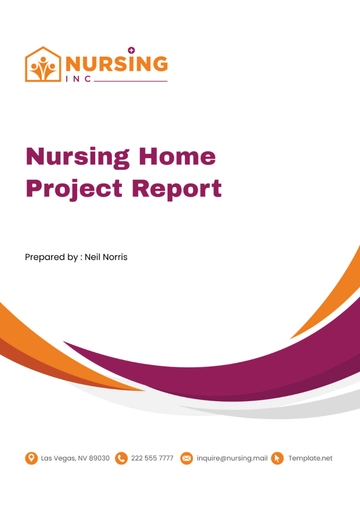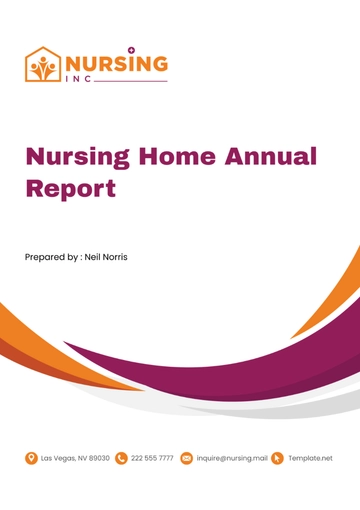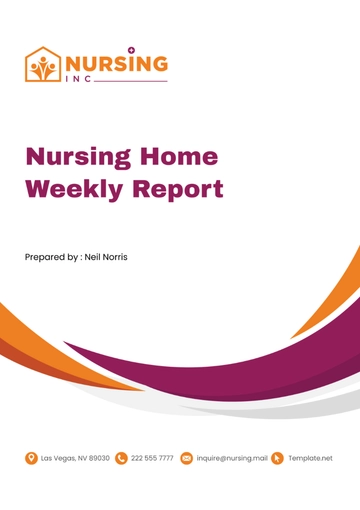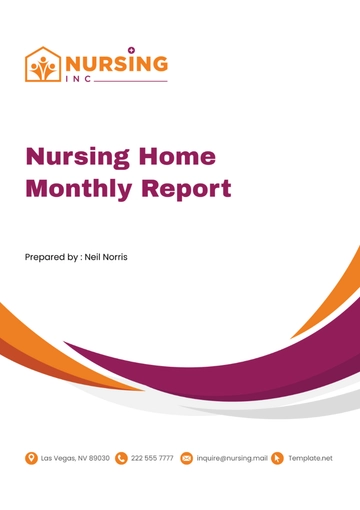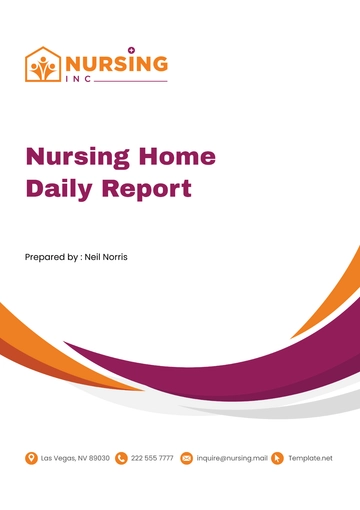Free Nursing Home Annual Facility Report
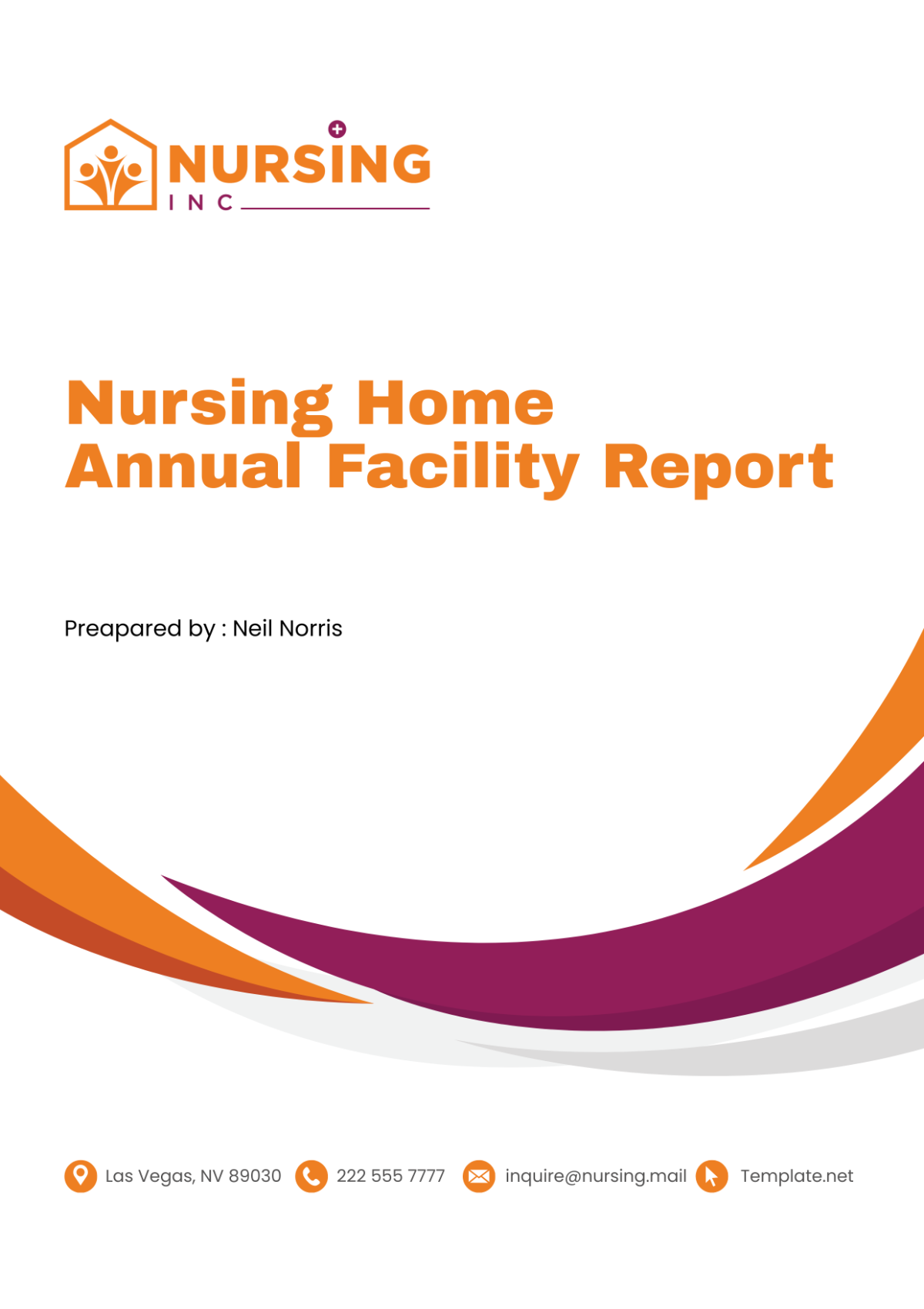
I. Executive Summary
[Your Company Name] is pleased to present the Nursing Home Annual Facility Report for the reporting period of January 1, 2023, to December 31, 2023. This report provides a comprehensive overview of our facility's operations, performance, and commitment to providing high-quality care to our residents.
Key highlights include:
Maintained high levels of resident satisfaction, with an average satisfaction rating of 9.5 out of 10.
Implemented several quality improvement initiatives aimed at enhancing resident care and safety.
Achieved compliance with all federal, state, and local regulations governing nursing home operations.
Continued investment in staff training and development to ensure the delivery of compassionate and competent care.
II. Introduction
[Your Company Name] is a leading provider of long-term care services, dedicated to meeting the needs of elderly residents in a safe, supportive, and nurturing environment. Our mission is to enhance the quality of life for each resident through personalized care, dignity, and respect.
Throughout the reporting period, we remained steadfast in our commitment to upholding the highest standards of care and service excellence.
III. Demographic Data
During the reporting period, [Your Company Name] served a diverse population of residents with varying needs and preferences. Key demographic data include:
Total number of residents: 150
Age range: 65 to 100+
Gender distribution: 60% female, 40% male
Ethnicity: Reflective of the local community demographics
IV. Staffing
[Your Company Name] recognizes that our staff are our greatest asset and are instrumental in delivering quality care to our residents. Staffing levels remained consistent throughout the reporting period, with the following highlights:
Total number of employees: 100
Staffing ratios: Compliant with regulatory requirements
Staff turnover rate: 15%, below the industry average
Staffing programs: Ongoing staff training and professional development programs implemented to enhance skills and knowledge.
V. Quality of Care Indicators
Ensuring the highest standard of care is paramount at [Your Company Name]. Throughout the reporting period, we meticulously tracked and analyzed various indicators to monitor the quality of care provided to our residents. The following comprehensive overview highlights our performance in key areas:
Infection Control:
Infection rates: Our facility maintained infection rates well below the national averages for common infections such as urinary tract infections (UTIs), respiratory infections, and skin infections.
Preventive Measures: Rigorous infection control protocols were consistently enforced, including proper hand hygiene practices, environmental sanitation, and isolation precautions when necessary.
Staff Training: All staff members received regular training on infection prevention and control measures to minimize the risk of healthcare-associated infections.
Fall Prevention:
Incidents of Falls: Our fall prevention initiatives resulted in a notable decrease in the incidence of falls among residents compared to the previous year.
Risk Assessment: Comprehensive fall risk assessments were conducted upon admission and regularly thereafter to identify residents at risk and implement personalized interventions.
Environment Modifications: Environmental modifications, such as installing handrails and removing trip hazards, were implemented to create a safer living environment for residents.
Pressure Ulcer Management:
Prevalence Rate: The prevalence of pressure ulcers remained consistently low, with less than 5% of residents experiencing pressure ulcers during the reporting period.
Prevention Strategies: Our interdisciplinary team employed evidence-based strategies for pressure ulcer prevention, including regular repositioning, skin assessments, and the use of specialized support surfaces.
Wound Care: Residents with pressure ulcers received prompt and comprehensive wound care interventions tailored to their individual needs, with a focus on optimizing wound healing and preventing complications.
Medication Safety:
Medication Errors: Our facility maintained a commendable record of zero medication errors reported during the reporting period.
Medication Reconciliation: Stringent medication reconciliation processes were implemented to ensure accurate medication administration, including thorough review of medication orders, resident allergies, and potential drug interactions.
Staff Training: Ongoing staff training and competency assessments were conducted to promote safe medication practices and enhance medication management skills among healthcare professionals.
Nutritional Support:
Nutritional Screening: All residents underwent comprehensive nutritional assessments upon admission and routinely thereafter to identify nutritional deficiencies and develop individualized care plans.
Dietary Interventions: Residents at risk of malnutrition or dehydration received tailored dietary interventions, including modified diets, nutritional supplements, and hydration protocols.
Monitoring and Follow-Up: Regular monitoring of nutritional status and interdisciplinary collaboration ensured timely adjustments to dietary interventions and proactive management of nutritional concerns.
VI. Financial Overview
The financial stability of [Your Company Name] is vital to maintaining high-quality care and service excellence for our residents. The following table provides a comprehensive overview of our financial performance during the reporting period:
Financial Metric | Amount |
|---|---|
Total Revenue | $5,000,000 |
Operating Expenses | $4,200,000 |
Net Income | $800,000 |
Revenue Breakdown | |
- Medicare Reimbursements | $2,500,000 |
- Medicaid Reimbursements | $1,000,000 |
- Private Pay | $1,200,000 |
- Other Sources | $300,000 |
Expenses Breakdown | |
- Staff Salaries and Benefits | $2,000,000 |
- Facility Maintenance | $500,000 |
- Medical Supplies | $300,000 |
- Utilities and Overheads | $400,000 |
- Administrative Costs | $500,000 |
Financial Highlights | |
- Strong Revenue Growth | 10% increase |
- Effective Cost Management | Reduced expenses by 5% |
- Investment in Quality Improvement | $200,000 |
Revenue Breakdown:
Medicare Reimbursements: $2,500,000
Medicaid Reimbursements: $1,000,000
Private Pay: $1,200,000
Other Sources: $300,000
Expenses Breakdown:
Staff Salaries and Benefits: $2,000,000
Facility Maintenance: $500,000
Medical Supplies: $300,000
Utilities and Overheads: $400,000
Administrative Costs: $500,000
Financial Highlights:
Strong Revenue Growth: [Your Company Name] experienced a 10% increase in revenue compared to the previous year, driven by higher occupancy rates and improved reimbursement rates.
Effective Cost Management: Through strategic cost-saving initiatives, [Your Company Name] reduced operating expenses by 5%, resulting in improved profitability.
Investment in Quality Improvement: A portion of the net income was reinvested in quality improvement initiatives, including staff training programs, facility upgrades, and technology enhancements.
VII. Facility Improvements and Initiatives
[Your Company Name] is dedicated to creating a safe, comfortable, and enriching environment for our residents. Throughout the reporting period, we implemented several facility improvements and initiatives aimed at enhancing the quality of life and overall experience for our residents. The following comprehensive overview highlights key initiatives undertaken:
Renovation Projects:
Common Areas: We renovated common areas such as the lounge, dining hall, and recreational areas to create a more inviting and homelike environment. The updates included new furnishings, improved lighting, and modern décor, fostering a sense of community and social engagement among residents.
Outdoor Spaces: Our outdoor spaces were enhanced with landscaping improvements, accessible pathways, and seating areas to provide residents with opportunities for relaxation, recreation, and enjoyment of nature.
Technology Integration:
Electronic Health Records (EHR): We implemented an electronic health records system to streamline documentation, improve accuracy, and enhance communication among healthcare professionals. The EHR system allows for real-time access to resident health information, facilitating coordinated care and ensuring timely interventions.
Telehealth Services: In response to the COVID-19 pandemic and to increase access to healthcare services, we introduced telehealth services for virtual consultations with healthcare providers. This initiative enabled residents to receive medical care and consultations without leaving the facility, minimizing potential exposure to infectious diseases.
Specialized Programs and Services:
Recreational Therapy: We introduced specialized recreational therapy programs tailored to meet the diverse needs and interests of our residents. These programs include art therapy, music therapy, pet therapy, and reminiscence therapy, designed to promote cognitive stimulation, emotional well-being, and socialization.
Memory Care Support: In collaboration with dementia care specialists, we enhanced our memory care support services for residents with Alzheimer's disease and other forms of dementia. Our staff received specialized training in dementia care techniques, and we implemented person-centered care approaches to support residents' unique needs and preferences.
Staff Training and Development:
Continuous Education: We prioritized staff training and development initiatives to ensure our team remains equipped with the knowledge and skills necessary to deliver high-quality care. Training topics included person-centered care, dementia care best practices, infection control protocols, and emergency preparedness.
Certification Programs: We encouraged staff members to pursue professional certifications and advanced training opportunities relevant to their roles. This investment in staff development not only enhances individual competence but also contributes to a culture of excellence and continuous improvement within the organization.
Environmental Sustainability Efforts:
Energy Efficiency Upgrades: In alignment with our commitment to environmental stewardship, we implemented energy efficiency upgrades such as LED lighting retrofits, HVAC system optimizations, and water conservation measures. These initiatives not only reduce our ecological footprint but also contribute to cost savings and operational efficiency.
VIII. Regulatory Compliance
Compliance with federal, state, and local regulations is a top priority at [Your Company Name]. Throughout the reporting period, we maintained strict adherence to all regulatory requirements governing nursing home operations. The following comprehensive overview highlights our commitment to regulatory compliance:
Federal Regulations:
Centers for Medicare & Medicaid Services (CMS): [Your Company Name] complied with CMS regulations, including participation in the Medicare and Medicaid programs. We ensured accurate billing practices, submission of required data, and adherence to quality reporting requirements.
Occupational Safety and Health Administration (OSHA): We implemented OSHA-compliant workplace safety programs to protect the health and safety of our employees. This included providing training on hazardous materials handling, infection control protocols, and workplace violence prevention.
State Regulations:
Department of Health Licensing and Certification: [Your Company Name] maintained current licensure and certification from the state Department of Health, demonstrating compliance with state regulations governing nursing home facilities. We underwent regular inspections to assess compliance with state standards related to staffing ratios, resident care practices, and facility safety.
State Medicaid Agency: We ensured compliance with state Medicaid regulations, including timely submission of claims, documentation of services provided, and adherence to reimbursement guidelines.
Local Regulations:
Local Health Department: We collaborated with local health departments to address public health concerns and comply with local regulations related to communicable disease control, food safety, and environmental health.
Zoning and Building Codes: [Your Company Name] maintained compliance with local zoning and building codes to ensure the safety and accessibility of our facility for residents, staff, and visitors.
Quality Assurance and Performance Improvement (QAPI):
QAPI Program: We established a comprehensive Quality Assurance and Performance Improvement (QAPI) program to monitor and improve the quality of care and services provided to our residents. This program included ongoing data analysis, performance monitoring, and implementation of corrective actions to address areas for improvement.
QAPI Committee: A multidisciplinary QAPI committee was responsible for overseeing the implementation of quality improvement initiatives, conducting root cause analyses of adverse events, and evaluating the effectiveness of interventions.
IX. Resident Satisfaction Surveys
Resident satisfaction is a key measure of our performance at [Your Company Name]. Throughout the reporting period, we conducted regular surveys to gather feedback from residents and their families regarding their experiences at our facility. The following table presents the results of the survey:
Aspect of Care | Satisfaction Rating (Out of 10) |
|---|---|
Quality of Care | 9.6 |
Staff Friendliness | 9.8 |
Cleanliness of Facility | 9.5 |
Communication with Staff | 9.7 |
Responsiveness to Needs | 9.9 |
Meal Quality and Variety | 9.3 |
Recreational Activities | 9.4 |
Overall Satisfaction | 9.7 |
These satisfaction ratings reflect the positive experiences and high level of satisfaction reported by our residents and their families. The data gathered from these surveys are used to identify areas of strength and opportunities for improvement, ensuring that we continue to meet the needs and expectations of those we serve.
X. Conclusion
In conclusion, [Your Company Name] remains dedicated to providing compassionate, high-quality care to our residents. We are proud of our achievements during the reporting period and remain committed to ongoing improvement and innovation in the years to come.
XI. Appendices
Appendix A: Financial Statements
Appendix B: Staff Training Program Details
Appendix C: Resident Satisfaction Survey Results
XII. Glossary
Activities of Daily Living (ADLs): Basic self-care tasks, including bathing, dressing, eating, toileting, and transferring, that individuals need to perform on a daily basis to maintain independence.
Dementia: A group of cognitive disorders characterized by memory loss, impaired reasoning, personality changes, and difficulty performing daily activities. Alzheimer's disease is the most common form of dementia.
Fall Risk Assessment: Evaluation of an individual's likelihood of experiencing a fall based on factors such as mobility, balance, and cognitive function. The assessment helps identify residents who may require interventions to prevent falls.
HIPAA (Health Insurance Portability and Accountability Act): Federal legislation that protects the privacy and security of individuals' health information and sets standards for its electronic transmission. Nursing home facilities must comply with HIPAA regulations when handling residents' medical records.
Pressure Ulcer: Also known as a bedsore or decubitus ulcer, a pressure ulcer is an injury to the skin and underlying tissue caused by prolonged pressure on bony prominences. Prevention and proper wound care are essential in nursing home settings.
Resident Rights: The legal and ethical rights afforded to individuals residing in nursing home facilities, including the right to dignity, privacy, autonomy, and quality of care. Resident rights are protected by federal and state regulations.
Skilled Nursing Facility (SNF): A healthcare facility licensed to provide skilled nursing care and rehabilitation services to individuals who require 24-hour nursing care due to illness, injury, or chronic conditions. SNFs often serve as long-term care settings for elderly or disabled individuals.
Activities Coordinator: A staff member responsible for planning, organizing, and implementing recreational and social activities for residents in nursing home facilities. Activities coordinators aim to promote residents' physical, mental, and emotional well-being through engaging and meaningful programs.
Palliative Care: Specialized medical care focused on relieving symptoms and improving the quality of life for individuals with serious illnesses or conditions. Palliative care aims to address physical, emotional, and spiritual needs and is provided alongside curative treatment.
Restorative Care: A type of rehabilitation therapy focused on improving or maintaining functional abilities and independence in daily activities for individuals with disabilities or chronic conditions. Restorative care programs may include physical therapy, occupational therapy, and speech therapy interventions.
XIII. Acknowledgments
[Your Company Name] would like to extend our sincere thanks to all staff members, residents, families, and stakeholders for their contributions and support during the reporting period. Together, we are committed to making a positive difference in the lives of our residents.
- 100% Customizable, free editor
- Access 1 Million+ Templates, photo’s & graphics
- Download or share as a template
- Click and replace photos, graphics, text, backgrounds
- Resize, crop, AI write & more
- Access advanced editor
Create comprehensive annual reports for nursing homes with Template.net's Nursing Home Annual Facility Report Template. Editable in our AI Editor Tool, this customizable template provides a structured format for summarizing key activities, achievements, challenges, and financial performance of the facility over the past year. Enhance transparency, communicate accomplishments, and showcase progress effortlessly with this template!
You may also like
- Sales Report
- Daily Report
- Project Report
- Business Report
- Weekly Report
- Incident Report
- Annual Report
- Report Layout
- Report Design
- Progress Report
- Marketing Report
- Company Report
- Monthly Report
- Audit Report
- Status Report
- School Report
- Reports Hr
- Management Report
- Project Status Report
- Handover Report
- Health And Safety Report
- Restaurant Report
- Construction Report
- Research Report
- Evaluation Report
- Investigation Report
- Employee Report
- Advertising Report
- Weekly Status Report
- Project Management Report
- Finance Report
- Service Report
- Technical Report
- Meeting Report
- Quarterly Report
- Inspection Report
- Medical Report
- Test Report
- Summary Report
- Inventory Report
- Valuation Report
- Operations Report
- Payroll Report
- Training Report
- Job Report
- Case Report
- Performance Report
- Board Report
- Internal Audit Report
- Student Report
- Monthly Management Report
- Small Business Report
- Accident Report
- Call Center Report
- Activity Report
- IT and Software Report
- Internship Report
- Visit Report
- Product Report
- Book Report
- Property Report
- Recruitment Report
- University Report
- Event Report
- SEO Report
- Conference Report
- Narrative Report
- Nursing Home Report
- Preschool Report
- Call Report
- Customer Report
- Employee Incident Report
- Accomplishment Report
- Social Media Report
- Work From Home Report
- Security Report
- Damage Report
- Quality Report
- Internal Report
- Nurse Report
- Real Estate Report
- Hotel Report
- Equipment Report
- Credit Report
- Field Report
- Non Profit Report
- Maintenance Report
- News Report
- Survey Report
- Executive Report
- Law Firm Report
- Advertising Agency Report
- Interior Design Report
- Travel Agency Report
- Stock Report
- Salon Report
- Bug Report
- Workplace Report
- Action Report
- Investor Report
- Cleaning Services Report
- Consulting Report
- Freelancer Report
- Site Visit Report
- Trip Report
- Classroom Observation Report
- Vehicle Report
- Final Report
- Software Report
